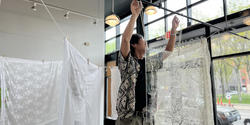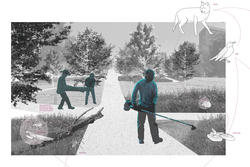The once-vibrant, multiracial Providence community was razed in the 1800s to make room for the railroad and the Rhode Island State House.
RISD Landscape Architecture Studio Challenges the Histories of Local Monuments

“We often see monuments and iconography in the built environment and gloss over it,” says Andrea Johnson, an assistant professor in the Landscape Architecture department. “It’s important to think about what histories are being oppressed and to take a more considered approach to historical analysis and contemporary design.”
This spring, graduate students enrolled in Johnson’s Monumental Publics studio explored the concept of the “retrocurrence”—the ability of an event or monument’s impact to be viewed simultaneously from multiple perspectives and at different points in time. Working with the Snowtown Research Collective, a group of Providence-area historians, archivists and archaeologists, students addressed how existing monuments can contribute to the oppression and erasure of marginalized communities and how to consider local landscape issues when designing new ones.
“In each of their projects,” says Johnson, “they’re considering how representations of history can be not erased but rather displayed in more complex ways, while also engaging with landscape issues like climate change, sea level rise and flooding.”
The first half of the class focused on an exploration of the history of Snowtown, a marginalized community located on Providence’s Smith Hill in the 1800s. Students were tasked with designing monuments that reconceptualize how we view the neighborhood, which has historically and inaccurately been characterized as a violent, crime-ridden red-light district.
Junyi Shi MLA 24 used mirrors to physically reflect mainstream media reports in an effort to highlight these complex histories, while Corey Watanabe MLA 24 strung up clotheslines draped with fabric in Kennedy Plaza as a memorial to the women of Snowtown. Naomi Canino MLA 24 explored Afrofuturism and the post-soul era by casting parts of their body and painting them with a color palette inspired by Black cultures, and Alexandra Goodenough MLA 24 created a banner that reads “whose stories lay under your feet?” in an attempt to quickly instill new ideas into the minds of passersby.

“Andrea’s enthusiasm, belief in us, continued encouragement and critical critique of our research really pushed us.”
After finalizing their Snowtown monuments, students applied the same thinking to public spaces in Boston. “There’s a really deep and rich history of grassroots activism in Boston,” explains Johnson, “so the students researched the histories of protests about highways, school segregation and public housing. They then used this research to think about how the city can promote and accommodate grassroots activism today.”
Canino focused their final project on the Boston Harbor Islands as “places of discard” that have hosted military outposts, prisons, asylums, Indigenous peoples internment camps and even garbage dumps over the years. “Using Peddocks Island as a case study, my project attempts to show multilayered, deeper histories within the soil to encourage a shift in management of Boston Harbor’s coastal islands,” they explain.
In contrast, Olivia Newroz MLA 24 reimagined one of Boston’s most popular public spaces, Boston Common, in an interrogation of the narrative of individual exceptionalism that prevails in many of its monuments. “By developing a system of mixed meadow grasslands and stormwater infrastructure surrounding them,” Newroz says, “I’m aiming to simultaneously diminish them in stature as well as bring them to the forefront of public discourse.” Newroz’s designs also consider maintenance systems, using specific plants that fortify the soil and create nesting habitats for local species.


Jen Ansley MLA 24 took their final project in a completely different direction by reimagining the historic South End Burial Ground through the process of human composting, a burial process that involves transforming the body into nutrient-rich soils that loved ones can use to enrich their own gardens or choose to donate to land conservation organizations. “The idea is that the compost could be used to contribute to the ecological health of these public green spaces,” they say, “which might also be spaces that are meaningful to [the families of those being composted here].”
Rather than focusing on a single space, Watanabe, Goodenough and Denzel Amoah MLA 24 centered their final project around neighborhoods in Roxbury with “limbo lots,” small plots that have the potential to be reclaimed by the community instead of being sold off to developers. “We are focusing on developing a code for design that centers community agency,” Amoah explains, “over the top-down governmental approach, which has historically prioritized the interests of large-scale developers.”
“Andrea’s enthusiasm, belief in us, continued encouragement and critical critique of our research really pushed us,” says Canino. “The course helped us to develop a deeper understanding of how to view memorialization as not just stagnant moments in time but a continued recognition of history.”
Isabel Roberts / top image shows work by Corey Watanabe / exhibition images by Simone Solondz
June 8, 2023


